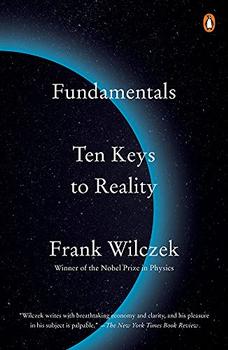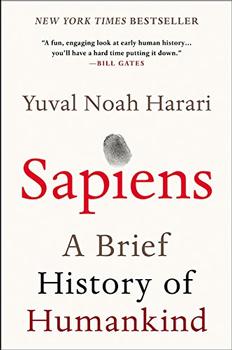Summary | Excerpt | Reviews | Beyond the book | Read-Alikes | Genres & Themes | Author Bio

Discovering the Common History of Rocks, Planets, and People
by Neil ShubinThe Universe Within is paleontologist and evolutionary biologist Neil Shubin's exhilarating and accessible history of the universe for non-scientists, a grand tour of the 13.75 billion years from the Big Bang to speculation about the future of humankind, our planet and the cosmos. Shubin surveys inner and outer space – he examines cells, genes and atomic particles, as well as global geological catastrophes and massive cosmic events. Though the trip is dizzying in scope, we keep our bearings because a central idea, one that Shubin repeatedly demonstrates and celebrates, steadies us: everything in the universe is connected to everything else, ourselves included. As Shubin explains, "Written inside us is the birth of the stars, the movement of heavenly bodies across the sky, even the origin of days themselves."
 Shubin begins and ends his book with an account of an expedition to Greenland during which he and his fellow paleontologists searched for and found fossilized teeth the size of grains of sand. The teeth belonged to a 200 million year-old shrew-like animal that is important because its teeth, ears, shoulders, limbs and skull are mammalian in structure, illuminating the development of our own mammalian anatomy. The book's middle includes chapters on the birth of the solar system; the formation and development of our planet; on time and the cells in our brain that measure it; the appearance of life on earth and its development from single cells to large, gravity-bound creatures; the relationship between oxygen, living things and the planet; tectonic plates and continental drift; global catastrophes and extinctions; the way rock erosion and weathering affect climate; and ice ages and climate change. No summary can do justice to the range of information or rich details Shubin gives the reader, or his knack for presenting complex ideas in sharp, clear language.
Shubin begins and ends his book with an account of an expedition to Greenland during which he and his fellow paleontologists searched for and found fossilized teeth the size of grains of sand. The teeth belonged to a 200 million year-old shrew-like animal that is important because its teeth, ears, shoulders, limbs and skull are mammalian in structure, illuminating the development of our own mammalian anatomy. The book's middle includes chapters on the birth of the solar system; the formation and development of our planet; on time and the cells in our brain that measure it; the appearance of life on earth and its development from single cells to large, gravity-bound creatures; the relationship between oxygen, living things and the planet; tectonic plates and continental drift; global catastrophes and extinctions; the way rock erosion and weathering affect climate; and ice ages and climate change. No summary can do justice to the range of information or rich details Shubin gives the reader, or his knack for presenting complex ideas in sharp, clear language.
Shubin humanizes science. He includes descriptions of the "bad choices" he made as a novice Arctic explorer - his slippery, leaky boots, too-small tent, large flashlight, too large for a place with 24 hours of sunlight. There are comic interludes among rhapsodic passages, and through biographical sketches of revolutionary scientists, Shubin show us how advances in science really happen. He describes the way scientists do their work - whether crawling over rocks, collecting masses of data, building new tools or persevering after being told an idea is worthless. These scientists, Shubin says, knew "how to look" at the world. For them, "...rocks and bodies" are not inert lumps of matter but, "...time capsules that carry the signature of great events that shaped them." Notable are Henrietta Leavitt (see Beyond the Book), whose charting of stars' brightness provided a way to measure distances in space, and the shy but intrepid archaeologist Dorothy Garrod, discoverer of Natufian culture, who provided the following description of her archaeological work: "You crawl on your stomach for hours...climbing up yawning abysses … and get knocked on the head by stalactites...and in the end arrive at all sorts of wonders."
To read The Universe Within is to arrive at all sorts of wonders: "The molecules that compose our bodies arose in stellar events in the distant origin of the solar system. Changes to Earth's atmosphere sculpted our cells and entire metabolic machinery. Pulses of mountain-building, changes in orbits of the planet, and revolutions within Earth itself have had an impact on our bodies, minds, and the way we perceive the world around us." Shubin illuminates our inner and outer selves and our world, and demonstrates how beautifully connected, transitory, rare, and changeable we are.
About the Author
Neil Shubin deserves a place among the fascinating scientists he profiles. He is the Robert R. Bensley Professor at the University of Chicago, and is also the Associate Dean, Biological Sciences Division. He is a Professor on the Committee on Evolutionary Biology, and serves as a Provost at The Field Museum in Chicago. Shubin works in the fields of organismal biology, anatomy, evolutionary biology, and paleontology, searching for "mechanisms behind the evolutionary origin of new anatomical features and faunas." In 2004 he was part of the team that discovered 375 million-year-old fossil Tiktaalik, the "missing link" between sea animals and creatures that walked on land. His first book for non-scientists was Your Inner Fish, A Journey into the 3.5-Billion-Year History of the Human Body.
![]() This review was originally published in The BookBrowse Review in January 2013, and has been updated for the
October 2013 edition.
Click here to go to this issue.
This review was originally published in The BookBrowse Review in January 2013, and has been updated for the
October 2013 edition.
Click here to go to this issue.

If you liked The Universe Within, try these:

by Frank Wilczek
Published 2022
One of our great contemporary scientists reveals the ten profound insights that illuminate what everyone should know about the physical world.

by Yuval Noah Harari
Published 2018
A groundbreaking narrative of humanity's creation and evolution that explores the ways in which biology and history have defined us and enhanced our understanding of what it means to be "human."
Your guide toexceptional books
BookBrowse seeks out and recommends the best in contemporary fiction and nonfiction—books that not only engage and entertain but also deepen our understanding of ourselves and the world around us.